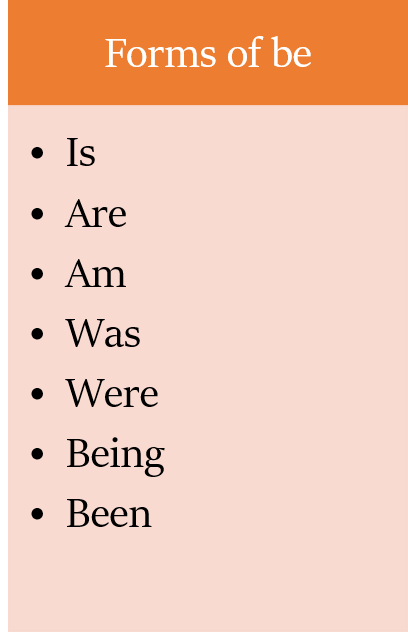Auxiliary Verb 'be'
In this article we are going to study about the Auxiliary Verb ‘be’.

‘be’ as helping verb and main verb
‘be’ can function as helping verb.
I was sleeping in the attic. (was – helping verb; sleeping – main verb)
‘be’ can also be used as the main verb in a sentence.
I am a teacher. (am – working here as main verb)
Uses of ‘be’
Use Case 1: Affirmative sentences
Various forms of auxiliary verb ‘be’ are used in the formation of affirmative sentences.
They can be used to denote an action or a state (i.e. when there is no action).
Pattern of affirmative sentences: Subject + am/is/are/was/were + Action verb
Pattern of affirmative sentences: Subject + am/is/are/was/were
She is dancing in the hall. (is - helping verb; dancing – action verb)
She is sad. (is – main verb and state verb; sad - adjective)
Use Case 2: Negative sentences
Various forms of auxiliary verb ‘be’ are used in the formation of negative sentences.
Pattern of negative sentences: Subject + am/is/are/was/were + not + Action verb
Pattern of negative sentences: Subject + am/is/are/was/were + not
She is not dancing right now. (is - helping verb; dancing – action verb)
She is not happy. (is – main verb and state verb; happy - adjective)
Use Case 3: Interrogative sentences
Various forms of auxiliary verb ‘be’ are used to make interrogative sentences.
Pattern of interrogative sentences: am/is/are/was/were + Subject + (not) + Action verb
Pattern of interrogative sentences: am/is/are/was/were + Subject + (not)
Is she playing right now? (is - helping verb; playing – action verb)
Is she depressed? (is – main verb and state verb; depressed - adjective)
Is she not happy? (is – main verb and state verb; happy - adjective)
Use Case 4: Tenses
Various forms of auxiliary verb ‘be’ help the main verbs in expressing the tense.
The auxiliary ‘be’ is used in the formation of the continuous tenses.
He is playing. (present continuous tense)
I was playing. (past continuous tense)
Use Case 5: Passive voice
Various forms of auxiliary verb ‘be’ are used in the formation of the passive voice.
The store was closed. (passive voice)
With infinitives we witness the following pattern:
Passive Voice Pattern: Subject + am/is/are/was/were + to + be + $V_3$ + …
A letter is to be written.
In case of active voice we follow the following pattern:
Active Voice Pattern: Subject + am/is/are/was/were + to + $V_1$ + …
You are to write a letter.
Use Case 6: Infinitives
We also use ‘be’ along with infinitives.
Pattern: Subject + am/is/are/was/were + to + $V_1$ + …
‘be’ followed by the infinitive is used:
to indicate a plan, arrangement, or agreement.
We are to appear in court tomorrow.to denote command.
Our instructor says we are to exercise for one hour everyday.

Extra Books and Tools
If you prefer to learn via books, or want some good English Grammar books for reference purposes, you may read this article which enlists some of the books recommended by us.